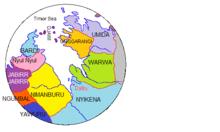Nyigina
The Nyikina people (also spelt Nyigina and Nyikena, and listed as Njikena by Tindale) are an Aboriginal Australian people of northern Western Australia. They come from the lower Fitzroy River (which they call mardoowarra).

Language
The Nyigina language is one of several eastern varieties of the Nyulnyulan languages, closely related to Warrwa and Yawuru.[1] It is still (2012) spoken by around 10 people.[2]
Education
The Nyigina, together with the Mangala people, run the Nyikina Mangala Community School a school at Jarlmadangah in West Kimberley. The Nyigina-Mangala peoples also run another school, together with the Walmajarri, at Looma.
Native title
In 1998 the Nyigina people undertook legal proceedings to pursue their native title claims. One consisted of a Nyikina Mangala claim, which they shared with the Mangala while the other comprised the Nyikina- Warrwa pursued together with the closely related Warrwa people. The Shire of Derby settled an Indigenous Land Use Agreement (ILUA) with the Indigenous plaintiffs, regarding the Nikina Mangala area, and set down a protocol that provided guarantees for surveying the Aboriginal cultural heritage before any development projects on the land could be undertaken. In 2014, after an 18-year legal battle, the Federal Court of Australia granted the Nyikina-Mangala petitioners native title over 26,000 square kilometres (10,000 sq mi) of territory, from King Sound through the Fitzoy Valley to the Great Sandy Desert.[3]
Prominent people
- Paddy Roe was an Nyigina elder who wrote about Nyigina culture and religion.
- Butcher Joe Nangan was a Nyigina Mabanjarra, songman, and artist.
Notes
- This map is indicative only.
Citations
- McGregor 2006, p. 115.
- Bowern 2012, p. 9.
- Kimberley Land Council 2014.
Sources
- "After 18 years, Traditional Owners of the Fitzroy River get native title". Kimberley Land Council. 29 May 2014.
- "AIATSIS map of Indigenous Australia". AIATSIS.
- Bowern, Claire (2012). A Grammar of Bardi. Mouton Grammar Library. Volume 57. Walter de Gruyter. ISBN 978-3-110-27818-7.CS1 maint: ref=harv (link)
- McGregor, William (2006). "Prolegomenon to a Warrwa grammar of space". In Levinson, Stephen C.; Wilkins, David P. (eds.). Grammars of Space: Explorations in Cognitive Diversity. Language Culture and Cognition. Volume 6. Cambridge University Press. pp. 115–155. ISBN 978-1-139-45839-9.CS1 maint: ref=harv (link)
- "Nyikina Mangala and Shire of Derby-West Kimberley Native Title Process Agreement Map" (PDF). Geospatial Analysis & Mapping Branch, National Native Title Tribunal. 25 October 2014.CS1 maint: ref=harv (link)
- "Tindale Tribal Boundaries" (PDF). Department of Aboriginal Affairs, Western Australia. September 2016.